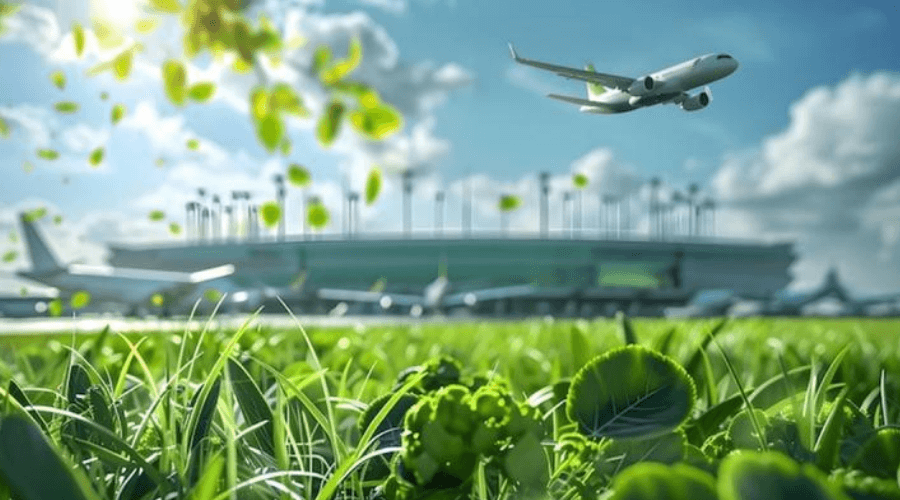The aviation industry, once considered one of the largest contributors to carbon emissions, is now soaring toward a cleaner and more sustainable future. In 2025 and beyond, the focus on sustainable aviation and eco-friendly flights is redefining how we travel across the globe. With innovations in fuel technology, electric aircraft, and smarter flight operations, the dream of green air travel is quickly becoming a reality.
This transformation isn’t just about saving the planet—it’s about reimagining the entire air travel experience. Airlines, manufacturers, and travelers are all embracing sustainability as the new standard. Let’s explore the breakthroughs driving eco-friendly aviation into a new era and how these innovations are shaping the future of flight.
1. The Rise of Sustainable Aviation Fuel (SAF)
One of the biggest game-changers in sustainable aviation is the development of Sustainable Aviation Fuel (SAF). Unlike traditional jet fuel derived from crude oil, SAF is made from renewable sources such as waste cooking oil, agricultural residues, and even algae. This eco-friendly alternative can reduce greenhouse gas emissions by up to 80% compared to conventional jet fuel.
Airlines like Delta Airlines, Airbus, and Boeing are leading the charge by investing heavily in SAF production. According to IATA, the use of SAF is projected to grow exponentially by 2030 as more airports and refineries adapt to its use.
Additionally, partnerships like Shell Aviation and World Energy are working on scaling up SAF production globally, ensuring affordability and accessibility for airlines worldwide.
Pro Tip: Travelers can support eco-friendly flights by choosing airlines that use or invest in SAF for their operations.
2. Electric and Hybrid Aircraft: The Next Generation of Flight
Electric and hybrid-powered aircraft are paving the way for a revolution in green air travel. By replacing or supplementing jet engines with electric propulsion, these aircraft drastically reduce carbon emissions and noise pollution while offering smoother, more efficient operations.
Companies like Rolls-Royce, Eviation (creator of the “Alice” electric aircraft), and Embraer are developing all-electric or hybrid commercial planes capable of short to medium-haul flights. Eviation’s Alice, for example, can carry up to nine passengers on 100% electric power with zero emissions.
Hybrid aircraft, which combine conventional fuel engines with electric systems, are also emerging as a transitional technology until full electrification becomes feasible for larger planes. The goal? Achieve completely eco-friendly aviation within the next two decades.
Internal link suggestion: Learn more about future innovations in our post Future Tech: 10 Emerging Innovations Changing the World.
Pro Tip: Electric aircraft are expected to reduce flight costs by up to 40%, making sustainable travel not just greener—but cheaper.
3. Hydrogen-Powered Planes: The Clean Fuel Revolution
Hydrogen is quickly becoming the holy grail of sustainable aviation. When used as fuel, hydrogen produces only water vapor—making it a zero-emission alternative to fossil fuels. Airbus, one of the leaders in aviation innovation, plans to launch the world’s first hydrogen-powered commercial plane by 2035 under its ZEROe project.
Hydrogen can be used in two main ways: combustion engines (burning hydrogen like traditional fuel) or fuel cells (converting hydrogen into electricity). The latter offers even greater efficiency and sustainability.
Challenges such as storage, safety, and refueling infrastructure remain, but advances in cryogenic storage technology are rapidly addressing these issues. Governments in Europe and Asia are already funding hydrogen aviation research to accelerate its deployment.
Pro Tip: Hydrogen planes could cut aviation’s total carbon footprint by 30–40% within the next 20 years, marking a major leap toward eco-friendly flights.
4. Smarter Flight Routes and Air Traffic Management
Technology isn’t just changing aircraft—it’s transforming how they’re flown. Modern air traffic management systems are using artificial intelligence and real-time analytics to optimize flight paths, reducing both fuel consumption and emissions.
Systems like EUROCONTROL in Europe and NextGen in the U.S. are implementing next-generation air navigation tools to streamline operations. Smarter routing minimizes holding patterns, shortens flight times, and reduces unnecessary fuel burn.
Additionally, predictive weather analytics powered by AI help pilots choose the most fuel-efficient flight paths while avoiding turbulence and adverse weather conditions. These digital solutions make green air travel not just a future vision, but a reality today.
Pro Tip: Improved flight management systems can cut carbon emissions by up to 10% across global aviation annually.
5. Lightweight Aircraft Design and Sustainable Materials
Modern aircraft design is undergoing a transformation, with engineers focusing on lightweight, durable, and sustainable materials to enhance efficiency. By using advanced composites, carbon fiber, and even bio-based materials, manufacturers can significantly reduce an aircraft’s overall weight and fuel consumption.
For instance, Boeing’s 787 Dreamliner uses carbon-fiber-reinforced polymers, cutting fuel use by 20%. Meanwhile, companies like Airbus are experimenting with 3D-printed and biodegradable materials to reduce manufacturing waste.
In 2025, the next phase of eco-friendly flights includes recycled materials and closed-loop production systems, ensuring that aircraft parts are reused or repurposed rather than discarded.
Pro Tip: Every 1% reduction in aircraft weight can save hundreds of gallons of fuel annually—proof that lighter truly means greener.
6. Airport Sustainability Initiatives
Airports are playing a crucial role in driving sustainable aviation forward. From solar-powered terminals to electric ground vehicles, airports are becoming sustainability hubs in their own right.
For example, Heathrow Airport has implemented a carbon-neutral strategy with renewable energy and zero-waste goals. Similarly, Amsterdam Schiphol Airport operates partially on wind power and uses electric buses for passenger transport between terminals.
Additionally, eco-friendly airports are investing in water conservation systems, smart lighting, and green roofs to minimize environmental impact. This holistic approach ensures the entire ecosystem of air travel—from takeoff to touchdown—supports green air travel.
Pro Tip: Choose airlines that operate out of eco-certified airports to further reduce your carbon footprint while traveling.
7. Offsetting Carbon Emissions: A Step Toward Cleaner Skies
Until aviation becomes completely carbon-neutral, carbon offset programs offer a way for travelers to balance their environmental impact. Airlines such as Qantas and British Airways allow passengers to offset their flight emissions by funding renewable energy, reforestation, and conservation projects worldwide.
Carbon offsetting is also becoming more transparent, with platforms like Climeworks using direct air capture technology to remove carbon dioxide directly from the atmosphere. These initiatives complement eco-friendly flights by making air travel more sustainable during the transition to zero-emission aircraft.
Internal link suggestion: Discover more on sustainability efforts in our post Net-Zero Homes: The Future of Sustainable Living.
Pro Tip: Even small carbon offset contributions can make a meaningful difference in promoting green air travel.
8. The Role of Government Policies and Global Collaboration
Government initiatives and global cooperation are vital to achieving true sustainable aviation. Programs such as CORSIA (Carbon Offsetting and Reduction Scheme for International Aviation) are setting global emission standards and promoting transparency across the industry.
Countries like Norway, Japan, and the United States are offering tax incentives and funding for research into eco-friendly flights and infrastructure. Collaboration between governments, airlines, and technology firms ensures consistent progress toward shared sustainability goals.
Furthermore, international summits such as COP28 are pushing aviation decarbonization to the forefront of climate discussions, encouraging nations to invest in greener technologies and alternative fuels.
Pro Tip: Policy-driven innovation is accelerating progress, ensuring that green air travel is not just a choice—but a global commitment.
Final Thoughts: The Flight Path to a Greener Tomorrow
The journey toward sustainable aviation is one of the most exciting transformations in modern history. From electric aircraft and hydrogen fuel to carbon-neutral airports and AI-optimized flight routes, the future of eco-friendly flights is taking shape faster than ever before.
For travelers, airlines, and governments alike, green air travel represents more than environmental responsibility—it’s a commitment to innovation, efficiency, and a cleaner world. As we enter a new era of air transportation, every flight brings us closer to a sky without compromise: one where sustainability and progress truly take flight.




